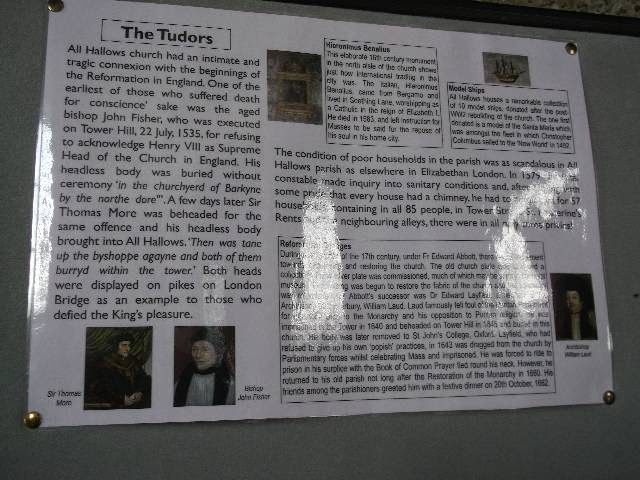Byward Street EC3R
5BJ
Thursday April 24th
2014
This visit was to
provide something of a contrast to the Gold of Mammon that had been our
previous visit, to the Bank of England Museum.
It is not a very long walk from Bank, essentially a gentle eastward
incline though it is not advisable to dawdle on the comparatively narrow
pavements of the City of London as you may well get shunted aside by someone in
a hurry.
We did not really
know what we were looking for but the church is a sizeable edifice that seems
to stand on a kind of island on Byward Street very close to the Tower of
London. You really cannot miss it. I was
doubtful about who could form part of the congregation of such a church, there
being a distinct shortage of local homes, but once inside the distinctly
rebuilt interior it seemed clear it is still quite a lively local church
offering itself as a sanctuary for ‘city workers’. Certainly the Kitchen, which
is the church’s café, smelt most appetising and has an entrance straight onto
the plaza area which fronts the modern glass building. During our visit the
Organist / an organist was having a practice for a scheduled lunch-time
recital, which added to the atmosphere.
The Church claims to
be the oldest in the City with origins going back to Saxon times, the Arch for
example, but due to some inexpertly kept gunpowder sacks the whole building went
up in a boom just in time to be rebuilt in a post Reformation style, with a
sturdy brick tower, to survive the Great Fire of 1666; in fact Pepys climbed
said tower in order the better to observe the extent and progress of the fire.
The building fared less well during the Blitz and was badly damaged, hence the
somewhat bland interior. However there are plenty of artefacts to keep one’s interest
and to warrant it counting as a Museum as well as a place of worship. There is
a strong Maritime theme with several ship models hung on the walls, a dedicated
chapel and a ship’s bell from a recent shipwreck.
The font cover is
displayed behind a grille as it is a beautiful piece by Grinling Gibbons. Here is an artist whose key works have to
be seen where he completed them, and this one seems to soar towards heaven.
If you can manage the
few steep steps down to the crypt there are other treasures on display – it’s a
charmingly mixed bag which somehow summarises the history of London – a
tessellated floor complete with drainage channel from a Roman home and a glass
case of that strongly earth coloured Samian ware and some burial plaques – the
light was a bit low to decipher the (Latin) text. Unusually (because many of these artefacts,
if not destroyed in the Reformation, definitively went during the Civil War)
the church has a lovely carved alabaster plaque, which apparently was stolen fairly recently but recognised and returned.
The church’s
registers – impressive ledgers – are also displayed to show that William Penn
was baptized here and another book certifies the marriage between Samuel
Adams and his wife. These US connections have ensured periodic
sponsorship of different restoration or building projects.
As ever we could have
lingered longer and certainly the church offered not only a welcome contrast to
our earlier visit but also to the bustle of tourists heading for the Tower of
London.






No comments:
Post a Comment